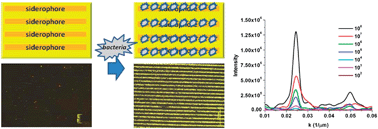Label-free detection of a bacterial pathogen using an immobilized siderophore, deferoxamine†
Abstract
Pathogenic bacteria obtain the iron necessary for survival by releasing an

* Corresponding authors
a
Department of Chemistry, Purdue University, West Lafayette, Indiana, U.S.A
E-mail:
plow@purdue.edu
Fax: +765-494-5272
Tel: +765-494-5273
b Department of Physics, Purdue University, West Lafayette, Indiana, U.S.A
Pathogenic bacteria obtain the iron necessary for survival by releasing an

 Please wait while we load your content...
Something went wrong. Try again?
Please wait while we load your content...
Something went wrong. Try again?
Y. Kim, D. P. Lyvers, A. Wei, R. G. Reifenberger and P. S. Low, Lab Chip, 2012, 12, 971 DOI: 10.1039/C2LC20904G
To request permission to reproduce material from this article, please go to the Copyright Clearance Center request page.
If you are an author contributing to an RSC publication, you do not need to request permission provided correct acknowledgement is given.
If you are the author of this article, you do not need to request permission to reproduce figures and diagrams provided correct acknowledgement is given. If you want to reproduce the whole article in a third-party publication (excluding your thesis/dissertation for which permission is not required) please go to the Copyright Clearance Center request page.
Read more about how to correctly acknowledge RSC content.
 Fetching data from CrossRef.
Fetching data from CrossRef.
This may take some time to load.
Loading related content
